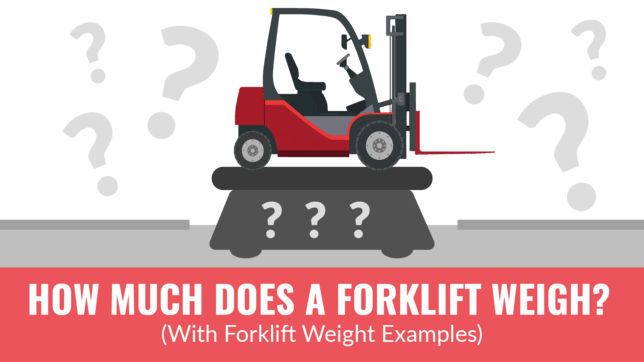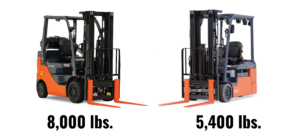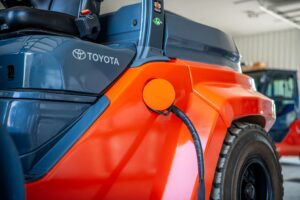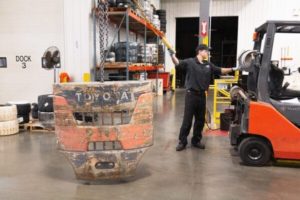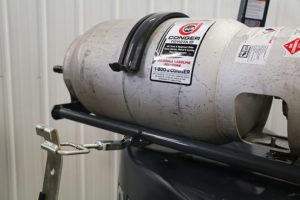Forklift weight is a critical factor in material handling, influencing safety, performance, and operational efficiency.
Understanding a forklift’s weight is crucial for safety and performance, as it impacts maneuverability, fuel efficiency, and lifting capacity, which are key factors when selecting the right forklift for your operation.
In this guide, we will explore forklift weight variations, their implications, and how to determine the right forklift weight for your operations.
Let’s dive in.
How Much Does a Forklift Weigh?
The weight of your average forklift (i.e., a 5,000 lb. capacity, cushion-tire warehouse forklift) is between 8,000 and 9,000 lbs.
Forklift weights vary widely, from 3,000 lbs. to over 140,000 lbs., depending on the make, model, and intended use.
Also, when talking about forklift weight, we refer to the service weight, not lifting capacity. The forklift service weight is the actual weight of the forklift itself, including forks or other accessories, but without a load.
Forklift weights range from 3,000 lbs. for the smallest sit-down rider forklifts to over 140,000 lbs. for the largest forklift trucks. Here’s a sampling of forklift weight ranges:
- Light-capacity forklifts: 3,000 lbs. – 4,999 lbs.
- Standard-capacity forklifts: 5,000 lbs. – 9,999 lbs.
- Medium-capacity forklifts: 10,000 lbs. – 19,999 lbs.
- High-capacity forklifts: 20,000 lbs. – 85,000+ lbs.
Different types of forklift trucks have varying weight ranges and operational aspects. For instance, stackers are lightweight and highly maneuverable, making them ideal for narrow aisles, while counterbalance forklifts offer greater lifting capacity and stability for heavier loads. Factors influencing forklift weight include load capacity and counterbalance.
Forklift weight is typically measured in two primary ways: gross weight and lifting capacity.
- Gross weight: Refers to the total weight of the forklift, including its frame, counterweight, battery (if electric), and any attachments. This measurement is crucial for transportation, floor load capacities, and overall stability.
- Lifting capacity: Denotes the maximum weight the forklift can safely lift and carry at a specified load center. The lifting capacity is always lower than the gross weight to ensure operational balance and stability.
Manufacturers provide these weight specifications on the forklift’s data plate, which should always be referenced for accurate and safe use.
Why Forklift Weight Matters
Forklift weight is a critical factor that directly affects lifting capacity, stability, and overall safety. Heavier forklifts generally support higher lifting capacities but may come at a higher cost and require more powerful engines or batteries. At the same time, weight plays a key role in stability—an overly heavy forklift may be harder to maneuver, while a lighter one might not provide the necessary balance for carrying heavy loads.
Beyond performance, knowing a forklift’s weight is crucial for safe transportation, facility integrity, and preventing structural damage. When transporting a forklift, knowing its exact weight ensures that the right truck is used and that proper restraints secure the unit in place.
In warehouses or industrial facilities, forklift weight determines whether floors can support the load without damage. Ramps and multi-level operations also require careful weight assessments to prevent accidents, structural failures, or excessive wear on flooring.
Factors That Affect Forklift Weight
Forklift Type and Size
Forklifts are inherently heavy due to their construction from durable steel components designed to handle rigorous material handling tasks. Understanding the weight variations among different forklift types and their intended use is essential for ensuring safe and efficient operation.
Small electric forklifts are generally lighter and ideal for indoor use, while warehouse IC (Internal combustion) forklifts balance weight and maneuverability for mixed environments. Heavy-duty diesel forklifts, on the other hand, have significantly greater weight to support high-capacity lifting and outdoor operations.
These differences in weight directly impact a forklift’s stability, balance, and ability to handle loads, making it crucial to select the appropriate type for specific operational needs.
Power Source and Fuel Type
Diesel, propane, and electric forklifts each have distinct weight characteristics that directly impact their functionality.
- Diesel Forklifts: Known for their durability and power, diesel forklifts tend to be the heaviest due to their reinforced engine components and large fuel tanks. Their substantial weight enhances stability, making them particularly suited for outdoor environments and heavy-duty applications. However, this increased weight can limit their maneuverability in confined indoor spaces.
- Propane Forklifts: These forklifts offer a balanced weight profile, sitting between diesel and electric models. The propane tank itself adds to the overall weight, but they maintain a good combination of power and agility. Their versatility allows them to be used efficiently in both indoor and outdoor settings.
- Electric Forklifts: Generally the lightest option due to the absence of a combustion engine and fuel system. However, their batteries can significantly increase weight, particularly in larger-capacity models. The strategic weight distribution of the battery contributes to forklift stability, making them an ideal choice for warehouse operations where precision and maneuverability are critical.
Counterbalance System
How counterweights contribute to the overall forklift weight.
Counterweights play a crucial role in determining the overall weight of a forklift. A forklift’s service weight encompasses the weight of the truck itself, its battery, and any attachments, with counterweights being a key component. These counterweights are strategically positioned to counterbalance the load being lifted, preventing the forklift from tipping and maintaining operational safety. Without proper counterweights, a forklift’s ability to handle heavy loads efficiently would be compromised, increasing the risk of instability and accidents.
Determining Forklift Weight
The most reliable way to determine the weight of a forklift is by checking the manufacturer’s tag or data plate. This tag provides essential information, including the forklift’s service weight, which encompasses the weight of the truck, its battery, and all attachments.
If the manufacturer’s tag is unavailable, you can estimate the weight of a forklift by multiplying its lift capacity by a factor of 1.5 to 2.
For example, if a forklift has a lift capacity of 5,000 lbs, its weight should fall between 7,500 lbs and 10,000 lbs. This estimation method helps ensure that you have a good understanding of the forklift’s weight, which is vital for maintaining safety and operational efficiency.
Forklift Capacity and Lifting Capacity
Forklift capacity and lifting capacity are terms that are often used interchangeably, but they refer to different aspects of a forklift’s performance.
Forklift capacity is the maximum weight that a forklift can carry, while lifting capacity refers to the weight that a forklift can lift to a specific height. The lifting capacity is typically lower than the overall capacity because it accounts for the weight of the load and the distance from the load to the fulcrum.
Add an Image here
Knowing the forklift’s capacity ensures that you do not overload the machine, while understanding the lifting capacity helps you manage the height and stability of the load.
How Much Do Different Forklift Components Weigh?
Forklift Propane Tank Weight
An empty propane tank weighs about 33 lbs. and 69 lbs. when full.
Most often, steel, propane-powered forklifts use 33 lbs. tanks. But some tanks are 43 lbs. tanks. An aluminum forklift tank may weigh only 23 lbs. when empty and 56 lbs. when full. But these aren’t commonly used these days. You can read more about propane tanks in our How to Safely Change a Forklift Propane Tank post.
Forklift Battery Weight
This is an additional weight that is important to understand for electric forklifts. A typical 3-wheel forklift battery weighs around 2,000 lbs.
Forklift battery weight varies widely. At the low end, they can weigh around 600 lbs. At the high end, they can weigh 5,000 lbs. or more for the biggest electric lift trucks.
Forklift Tire Weight
The average forklift tire weighs about 50 lbs. Each.
Forklift tire weight depends on the tire type, service weight, and load capacity. Overall, forklift tires are relatively small but built to be solid and durable due to their tasks and activities.
H4: Cushion vs Pneumatic forklift tires
To better understand the weight differences between Cushion and Pneumatic tire forklifts, let’s examine two models from Toyota. The Toyota 8FGCU25 Core IC Cushion forklift has a gross weight of 8,000 lbs, while the Toyota 8FGU25 Core IC Pneumatic forklift weighs 7,840 lbs.
At first glance, this might suggest that Cushion tires are heavier than Pneumatics since that is the main difference between these models; however, in reality, Pneumatic tires are generally heavier than Cushion tires. The discrepancy arises because the mounting components for Cushion tires are often heavier than those used for Pneumatic tires leading to the cushion tire forklift having a heavier weight despite having lighter tires.
Forklift Weight by Brand
Toyota Forklift Weight
Forklift weight varies significantly depending on the brand, model, and lift capacity. Understanding forklift weight is crucial for safe operation, transport, and storage. Below, we break down the weight of different forklift models from four major brands: Toyota, Yale, Hyster, and Crown. The selected models represent a mix of popular, commonly used forklifts with varying capacities and power sources, providing a broad perspective on forklift weight across different applications.
Toyota Forklift Weight
Toyota forklifts are known for their reliability and efficiency. The models below include a balanced selection of internal combustion and electric forklifts, showcasing weight variations across different power types and lifting capacities.
|
Model |
Capacity (lbs) |
Approx. Weight (lbs) |
Power Source |
|
Toyota 8FGCU25 |
5,000 |
8,000 |
LPG |
|
Toyota THD3000 |
30,000 |
46,999 |
Diesel |
|
Toyota 8FBE20U |
4,000 |
(5,400 w/o battery) |
Electric |
Yale Forklift Weight
Yale forklifts offer a range of options, from electric models to high-capacity internal combustion units. The following selection reflects a mix of warehouse and heavy-duty forklifts.
|
Model |
Capacity (lbs) |
Approx. Weight (lbs) |
Power Source |
|
Yale ERP050VL |
5,000 |
(8,680 w/o battery) |
Electric |
|
Yale GDP300EF |
30,000 |
39,328 |
Diesel |
|
Yale GC080 |
8,000 |
12,650 |
LPG |
Hyster Forklift Weight
Hyster forklifts are designed for durability, making them ideal for demanding applications. The models listed cover a range of lifting capacities, from standard warehouse use to heavy-duty operations.
|
Model |
Capacity (lbs) |
Approx. Weight (lbs) |
Power Source |
|
Hyster H50XT |
5,000 |
8,910 |
LPG |
|
Hyster J40XNT |
4,000 |
(5,310 w/o battery) |
Electric |
|
Hyster H190XD |
19,000 |
28,402 |
Diesel |
Crown Forklift Weight
Crown specializes in electric forklifts and warehouse equipment, particularly counterbalance and narrow-aisle solutions. These models highlight their diverse range.
|
Model |
Capacity (lbs) |
Approx. Weight (lbs) |
Power Source |
|
Crown SC 524X-40 |
4,000 |
(6,260 w/o battery) |
Electric |
|
Crown C-5 1050-50 |
5,000 |
9,430 |
LPG |
|
Crown CD140S-7 |
31,000 |
39,675 |
Diesel |
Why these models?
This selection of forklifts showcases a range of capacities, power sources, and industry-standard models to provide a comprehensive comparison of forklift weights. The 5,000 lb internal combustion models, such as the H50XT and ERP050VL, represent a commonly used capacity, highlighting the weight differences between LPG and electric forklifts. The 8FBE20U and J40XNT demonstrate how much lighter electric models can be compared to combustion options. Heavier-duty diesel models, including the THD3000, GDP080VX, and H190XD, illustrate how forklift weight increases with lifting capacity.
What is the Average Forklift Weight in Tons?
As we mentioned earlier, the weight of your average forklift (i.e., a 5,000 lb. capacity, cushion-tire warehouse forklift) typically falls between 8,000 and 9,000 lbs. In terms of tons, this equates to 4 to 4.5 tons, since 1 ton is equal to 2,000 lbs.
If you need to determine the exact weight of a forklift, refer to the manufacturer’s tag or the service manual, which will provide the precise weight in pounds. To convert that weight to tons, simply divide the total pounds by 2,000.
Conclusion
Forklift weight plays a pivotal role in ensuring safe and efficient material handling operations. Heavier forklifts generally support higher lifting capacities and increased stability, while lighter models can be more maneuverable—especially useful in tight or indoor environments. Key factors that influence forklift weight include the power source (diesel, propane, or electric), the use of counterweights, and additional components such as batteries or tanks.
Because each forklift model is engineered differently, the most reliable way to verify a forklift’s actual weight is by referencing the manufacturer’s data plate or service manual. This helps avoid improper loading, transport, and storage—ultimately minimizing the risks of accidents, structural damage, or reduced productivity.
By recognizing how forklift weight affects performance, operators and facility managers can make better decisions when choosing, maintaining, and operating their lift trucks. This focus on understanding and adhering to proper weight specifications is essential for maximizing efficiency, meeting regulatory requirements, and upholding the highest standards of workplace safety.
